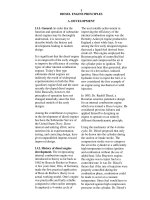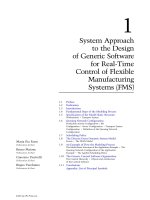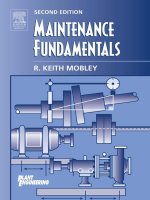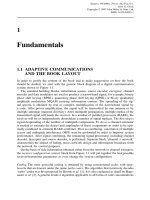Tài liệu Century Manufacturing P1 doc
Bạn đang xem bản rút gọn của tài liệu. Xem và tải ngay bản đầy đủ của tài liệu tại đây (1.1 MB, 40 trang )
Forward
This textbook series is published at a very opportunity time when the
discipline of industrial engineering is experiencing a phenomenal growth in China
academia and with its increased interests in the utilization of the concepts,
methods and tools of industrial engineering in the workplace. Effective utilization
of these industrial engineering approaches in the workplace should result in
increased productivity, quality of work, satisfaction and profitability to the
cooperation.
The books in this series should be most suitable to junior and senior
undergraduate students and first year graduate students, and to those in industry
who need to solve problems on the design, operation and management of
industrial systems.
Department ofIndustrial Engineering, Tslnghua University
School ofIndustrial Engineering, Purdue University
April, 2002
Contents
MANIIMC7VRlIIIG:AlIT.
RCHNOf.fHlY.
ISCI._
_D __ NBS
1.1 Introduction: What Is "Manufacturing"? I
1.2 The Art of Manufacturing (from 20,000
n.c.
to 1770 A.D.) 2
13 The Technology of Manufacturing: From the 1770s to the 1970s 5
1.4 A Science of Manufacturing: The 1980s to the Present 8
1.5 The Business of Manufacturing 13
1.6 Summary 15
1.7 References 17
1.8 Bibliography 18
1.9 Case Study: "The Next Bench Syndrome" 19
1.10 Review Material 19
2 _C7VRIIIIGJlNlU.YSIS: _. _ OU_
_ A STIIRJ'.III' __
2'
2.1 Introduction:www.start-up.cem 21
2.2 Question 1: Who Is the Customer? 22
2.3 Question 2: How Much Will the Product Cost to Manufacture (C)? 26
2.4 Question 3: How Much Quality
(Q)?
44
2.5 Question 4: How Fast Can the Product Be Delivered (D)? 57
2.6 Question 5: How Much flexibility (F)? 62
2.7 Management of Technology 65
2.8 References 67
2.9 Bibliography 70
2.10 Case Study 71
vII
,.,,_c.
•
•
vIII Contents
2.11 Interactive Further Work 79
2.12 Review Material 80
3 PRODUCT
"...6N,.
COMI'fITRI
AI"'"
DamN
(CADI.
AND.OUD -.LING .1
3.1 Introduction 81
3.2 Is There a Definition of Design? 82
3.3 The Artistic, Creative, or Conceptual Phase of Design 82
3.4 The High-Level Engineering Phase of Design 83
3.5 The Analytical Phase of Design 86
3.6 The Detailed Phase of Design 90
3.7 Three Tutorials: An Overview 90
3.8 First Tutorial: Wire-Frame Construction 91
3.9 Solid Modeling Overview 98
3.10 Second Tutorial: Solid Modeling Using Constructive Solid Geometry
(CSG) 104
3.11 Third Tutorial: Solid Modeling Using Destructive Solid Geometry
(DSG) 109
3.12 Management of Technology 113
3.13 Glossary 117
3.14 References 119
3.15 Bibliography 121
3.16 URLs of Interest: Commercial CAD/CAM Systems and Design
Advisers 122
3.17 Case Study 122
3.18 Question for Review 128
" .OUD ", ••
PORM
MBBlCAn_
(_I
ANDRAI'I-.rtITOTIfPING
130
4.1 Solid Freeform Fabrication (SFF) Methods 130
4.2 Stereolithography: A General Overview 133
4.3 Comparisons Between Prototyping Processes 149
4.4 Casting Methods for Rapid Prototyping 154
4.5 Machining Methods for Rapid Prototyping 158
4.6 Management of Technology 161
4.7 Glossary 163
4.8 References 165
4.9 Bibliography 168
4.10 URLs of Interest 168
4.11 InteractiveFurtherWork 169
5 •••••ICfINDIICTOBMANUMCTUBING
171
5.1 Introduction 171
5.2 Semiconductors 171
Contents
Ix
5.3 Market Adoption 172
5.4 The Microelectronics Revolution 174
5.5 Transistors 176
5.6 Design 182
5.7 Semiconductor Manufacturing I: Summary 184
5.8 Semiconductor Manufacturing II: NMOS 185
5.9 Layout Rules 189
5.10 More Details on Front-End Processing 192
5.11 Back-End Processing Methods 205
5.12 Cost of Chip Making 208
5.13 Management of Technology 213
5.14 Glossary 223
5.15 References 228
5.16 Bibliography 230
5.17 URLs of Interest 230
5.18 Appendix I: Worldwide Semiconductor Market Share 231
5.19 Appendix 2: Cost Model Variables in Year 2000--Example for a 64-
MB Dram (Courtesy Dataquest) 231
5.20 Review Material 232
233
6.1 Introduction 233
6.2 Printed Circuit Board Manufacturing 235
6.3 Printed Circuit Board Assembly 239
6.4 Hard Drive Manufacturing 248
6.5 Management of Technology 255
6.6 Glossary 262
6.7 References 264
6.8 Case Study on Computer Manufacturing 267
277
7.1 Introduction 277
7.2 Basic Machining Operations 280
7.3 Controlling the Machining Process 289
7.4 The Economics of Machining 302
7.5 Sheet Metal Forming 306
7.6 Management of Technology 315
7.7 Glossary 318
7.8 References 322
7.9 Bibliography 324
7.10 URLsofInterest 324
7.11 Interactive Further Work I: The Shear Plane Angle 324
7.12 Interactive Further Work 2: "Fixnirenet" 325
7.13 Review Questions 327
8
COM"""'. _IIMtnlRfNG
7
M8TAI.•••••
ODfIC1'S
..-uMtnIR,NG
Contents
" •••••tnJI:-PIIIIfHIC MAlfUMcnnr,1IIG
AND
"'lUll.
A••••• V 330
8.1 Introduction 330
8.2 Properties of Plastics 331
8.3 Processing of Plastics I: The Injection Molding Method 334
8.4 Processing of Plastics II: Polymer Extrusion 345
8.5 Processing of Plastics III: Blow Molding 346
8.6 Processing of Plastics IV; Thermoforming of Thin Sheets 346
8.7 The Computer as a Commodity: Design for Assembly and
Manufacturing 348
8.8 Management of Technology 456
8.9 Glossary 358
8.10 References 361
8.11 Bibliography 362
8.12 URLs of Interest 362
8.13 Case Study on Assembly 362
8.14 Interactive Further
work
364
8.15 Review Material 364
" BloncHNOI.OGY
3011
9.1 Introduction 366
9.2 Modern Practice of an Ancient Art 367
9.3 Capturing Interest 368
9.4 Milestones in Biotechnology History 369
9.5 A Bioscience Review 371
9.6 Bioprocesses 379
9.7 Genetic Engineering I: Overview 384
9.8 Genetic Engineering Il: Case Study on Gene Cloning of Hemoglobin 390
9.9 Bloprocess Engineering 395
9.10 Management of Technology 398
9.11 Glossary 402
9.12 References 404
9.13 Bibliography 405
-
10.1 Restatement of Goals and Context 406
10.2 Management of Technology 407
10.3 From the Past to the Present 408
10.4 From the Present to the Future 409
10.5 Principles of Organizational "Layering" 410
10.6 Layer I: The Learning Organization 411
10.7 Layer II: Compressing Time-to-Market 413
10.8 Layer III: Aesthetics in Design 414
10.9 Layer IV: Bridging Cultures to Create Leading Edge Products 415
'0 """"'"
A$P8CJ'S
Of' IIIIANfIMC7IIIIII11G
Contents
xl
10.10 Conclusions to the Layering Principle 420
10.11 References 420
10.12 Bibliography 421
_ A
_"DOK"
OF 'DDS FOR PIIO.IKTS.
'IVII_
AN".W'N'"
PlANS 423
A.I Who Want" to Be an Entrepreneur? 423
A2 Projects on Prototyping and Business 424
A3 Project Steps and Making Progress 425
A.4 Outline of a Short Business Plan 427
AS Project Selection 428
A6 Project 1: Enhanced Mouse-Input Devices 429
A.7 Project 2: Blimp-Cams, Cart-Cams, and Telepresence
Devices 430
A8 Project 3: Miniature Radios for Consumer Electronics 431
A.9 Project 4: GPS-Based Consumer Products 434
AID Consulting Projects 437
A.ll Overview of Possible Factory Tours 439
Al2 Rationale 439
A.13 Factory-Tour Case Study Write-Up 440
A.14 Suggested Format and Content for the Factory- Tour Case
Studies 441
A.I5 References 443
A.16 Bibliography 444
A.17 URLs of Interest 444
A.18 Case Study- The "Palm
Pilot"
444
'NIIIB
'''17
CHAPTER
MANUFACTURING: ART,
TECHNOLOGY, SCIENCE,
AND
BusINESS
1.1 INTRODUCTION: WHAT IS "MANUFACTURING"?
The word has Latin roots: manu, meaning by hand, joined to facere, meaning to make.
The dictionary definition is "Making of articles by physical/abor or machinery, espe-
cially on a large scale."
Even this simple definition shows a significant historical trend.
For hundreds of years. manufacturing was done by physical labor, in which a person
with hand tools used craft skills to make objects. Since the industrial revolution
200 years ago, machinery has played an increasing role, as summarized in the second
column of Figure 1.1. Also, the models for manufacturing processes have become
better understood. And in more recent decades, computer aided design and manu-
facturing (CAD/CAM) and new concepts in quality assurance (OA) have been intro-
duced to improve efficiency in production. It is expected that the 21st century will
bring even better process models, more exacting control, and increased integration.
During the early part of the 20th century, the words
largescale-used
above in
the dictionary definition-were synonymous with the mass production of Henry
Ford. Most people would agree that the present trends created by the Internet have
now set the stage for an even larger scale or global approach to manufacturing. We
can expect to see global networks of information and distributed manufacturing
enterprises. The 20th century concept of a monolithic organization clinging to one
centralized corporate ethos may fade. The new culture may well be smaller, more
agile corporations that can spring up for specific purposes, exist while the market sus-
tains the new product, and then gracefully disband as the market changes. The
Internet iscertainly providing the infrastructure for these more flexible and informal
ways of creating new enterprises that respond to people with a naturally entrepre-
neurial spirit. In Chapter 1, the goals are to set the stage for these broad views of
manufacturing and a new era of global change.
Early 18th Century
20th Century
Manufacturing: Art, Technology, Science, and Business Chap. 1
21st Century
Manufacturing: Past,Present,and Future
19th Century
A person with an
anvil and hammer
Poorly understood
process
Craftspeople
Cottage industry
Steam-powered
machinery
Improved
understanding of
processes
Faclory conditions in
cities
Computer aided
design,planning,and
manufacturing
Limited process
models using closed
loop control
Increased factory
automation
Systemwide networks
and information
Robust processes and
intelligent control
Global enrerprtses
and virtual .
manufacturing
corporations
Figufe Ll Four centuries of manufacturing leading to 21st century manufacturing.
1.2 THE ART OF MANUFACTURING (FROM 20,000 B.C.
TO 1770 A.D.I
In the most general sense, manufacturing is central to existence and survival. Histo-
rians connect the beginning of the last European Ice Age, approximately 20,000 years
ago, to a period in which "technology took an extTa spurt" (Pfeiffer, 1986). Cro-
Magnons retreated southward from the glacial ice that, more or less,reached what are
now the northern London suburbs. They manufactured rough pelts for warmth, simple
tools for hunting, and crude implements for cooking. This general period of prehistory
around 20,000
B.G
to 10,000
B.C.
is referred to as the Stone Age. The availability of
simple manufacturing tools and methods around the period of 10,000B.G also created
the environment for community living, rather than an opportunistic, nomadic-tribe
mentality. Such communities set the stage, at that time, for the agrarian revolution.
Manufacturing must have then evolved from these arts and crafts roots with
occasional similar spurts prompted by climate, famine, or war. For example, the acci-
dental discovery that natural copper ore, mixed with natural tin are, would produce
a weapon much more durable than stone replaced the Stone Age with the Bronze
Age. Archaeologists believe that bronze weapons, drinking vessels, and other oma-
ments were made in Thailand, Korea, and other Eastern civilizations as early as 5000
B.C.At a similar time, in the Western civilizations, the evidence suggests that tin was
mined in the Cornwall area of England. The two contemporaneous societies of Egypt
and Mesopotamia appeared on the historical scene around 3000 B.C.While the his-
torical roots of these cultures appear hazy, they were blessed wilh sophisticated arti-
sans (Thomsen and Thomsen, 1974). Their early arts and crafts skills were then
passed on to the Greeks and Romans, thereby setting the stage for European man-
ufacturing methods. These grew very slowly indeed until the Iron Age and, finally,the
industrial revolution of the 17th and 18th centuries.
One example of these early arts and crafts skills was the lost-wax casting
process. It was discovered by both the Egyptians and the Koreans around the period
5000 B.C.to 3000 B.G In the process, an artist carves and creates a wax modeI-say
1.2 The Art of Manufacturing (from 20,000 B.C. to 1770 A.D.)
of a small statue. Sand or clay is then packed around this wax model. Next, the wax
model is melted out through a small hole in the bottom to leave a hollow core. The
small hole is plugged, and then liquid metal is poured into a wider hole at the top of
the hollow cavity. After the metal freezes and sets, the casting is broken out of the
sand. Some hand finishing, deburring, and polishing render the desired art object.
Later chapters in the book will describe modern rapid-prototyping shops, connected
to the Internet, producing small batches of trial-run computer casings for AT&T, Sil-
icon Graphics, and IBM. These are high-tech operations by anyone's standards. Iron-
ically,however, this lost-wax process remains one of the basic processes that is widely
used in prototyping.
If the roots of forging and casting are with the Egyptian and Korean artisans,
what about slightly more complex processes such as turning and milling? Bronze
drinking vessels extracted by archaeologists from the tombs in Thebes, Egypt, show
the characteristic turned rings on their bases as if made on a crude lathe. (As
described later, a lathe is a turning machine tool, predominantly used today to
change the diameter of a bar of stee1.) The manufacturing date is estimated to be
before 26 B.C.,because Thebes was sacked in that year (Armarego and Brown, 1969).
In the British Museum and the Natural History Museum in New York, many art
objects show these characteristic turned circles from early machining operations.
Even the word lathe has romantic roots. It derives from the word lath, related
to the description for a flexible stick or slender tree branch used to spin the bar as
described below. Early lathes were operated by two people: one holding the tool, the
other turning the bar being machined. Sooner or later someone figured out (prob-
ably one of the exhausted turning guys) that one could rig up a crude system some-
thing like an old-fashioned sewing machine treadle. A rope was wrapped and looped
around the free end of the bar being machined. One end was.tied to the turner's foot,
rather like a stirrup; the other end was tied to the end of a springy stick or tree branch
(the lath) that was nailed up into the roof rafters. As the turner raised his foot up and
down, the motion rotated the bar back and forth, and the lath functioned as a return
spring for the rope. Obviously this was a relatively crude process from a modern day
view of achievable precision! But from the word lath comes today's word lathe. And
in Britain, the word "turner" is frequently used instead of the American word
"machinist" for the lathe operator.
This introduction to manufacturing from an artistic point of view brings up the
first thoughts on design for manufacturability (DFM) (see Bralla, 1998). It must be
clear from the above descriptions of open-die forging, casting, and machining that
there is always a trade-off between the complexity of the original design and how
easily it is made. It was certainly clear to the original artisans. In any natural history
museum showing European art, one can see many functional items such as cooking
pots, ordinary tools, eating implements that are rather dull looking: no fancy f1eurs-de-lis
or insets, no beautifully rounded corners. By contrast, exotic jewelry and necklaces do
contain these fanciful additions. The most decorative items are the handles and
scabbards of swords. These were obviously the most important objects to even an
average soldier's heart, and they were willing to pay relatively large sums of money
to the artisan to create beauty as well as functionality. Asian cultures had different
ways of demonstrating wealth or societal position, where simplicity was synonymous
Manufacturing: Art, Technology, Science, and Business Chap. 1
with beauty. Nevertheless, the very best materials and refined structures were
employed.
An economic analysis of design for manufacturability should always keep in mind
the ultimate customer.An overly fanciful,nearly impossible to fabricate sword scabbard
(or the 21st century equivalent) may be exactly what the customer wants and is happy
to pay for. But not all customers. Walmart, Kmart, and McDonald's show that the
greatest wealth is to be obtained from the mass markets where aesthetics and highest
quality materials are compromised in favor of low cost. Any new enterprise embarking
on the design, planning, and fabrication of a new product should therefore begin with
the market analysis. How much time and money go into each step of design, planning,
and fabrication is a recurring theme of this book. Without the best case reading of the
marketplace-to analyze which group of consumers is being targeted, how many items
will be sold, and at what margin-no amount of fabulous technology willwin.
The brief case study at the end of this chapter expresses the same opinion. The
article refers to "the next bench syndrome" coined at Hewlett-Packard. The idea is
that, in the past, engineering designers would create devices to impress their engi-
neering colleague seated at the next bench, rather than the ultimate consumer.
Today, the evidence is that HP products have improved, now that its designers have
redirected their efforts to become more customer oriented. The article also mentions
the early (1993-1994 era) prototypes of pen-input computers. Some readers may
recall how bulky and slow these were. But today, designers and manufacturers
understand what consumers genuinely want from mobile, palm-size, pen-input
devices: for example, the Palm Pilot and similar products have now become well
established, useful consumer products.
This section is entitled "The Art of Manufacturing," and it introduces the
important link between design and manufacturing (DFM).The relationship between
art, design, and manufacturing is complex. The word art is derived from the Latin ars,
meaning skill. Thus, especially before the industrial revolution (1770-1820), new
products were designed and manufactured by artists and craftspeople: their hand
skills were predominant. By contrast, in the modem era, new products are most
likely to be designed and manufactured by mathematically trained engineers. Today,
some degree of intuition, and trial and error, is still needed on the factory floor to
operate machinery and to set up other equipment effectively, but throughout the
21st century, the role of the craftsperson or artisan will fade away.
Does this mean that art will no longer playa role in design and manufacturing?
The answer is "probably not," because art involves more than just a hand skill itself.
Most scholars of art describe the concept of aesthetic experience that elevates a basic
skill into the artistic reahn. It is observed that the most successful artists-in any field
such as music, dance, literature, painting,
architecture,
or
sculpture-e-cornmunicate
an aesthetic experience to their audience. Communication of this aesthetic experi-
ence to the consumer will always be key for the "design artist" or "manufacturing
artist" no matter how mathematically sophisticated and high-tech these fields even-
tually become. As this book moves on to the technology and business of manufac-
turing, it is suggested that new students in the field keep this concept of aesthetic
experience in mind.
1.3 The Technology of Manufacturing: From the 1770s to the 1970s
1.3 THE TECHNOLOGY OF MANUFACTURING:
FROM THE 1770s TO THE 1970s
The first watershed that changed manufacturing from a purely artistic or at least artisan
type endeavor must surely have been the industrial revolution in England, which took
place in the approximate period 1770to 1820.The most gifted historians have come up
with no single reason for this revolution (Plumb, 1965;Wood, 1963).It was a combina-
tion of technological, economic, and political factors, as follows:
L A rapid increase in the day-to-day health and living conditions of people, hence
increased population for marketing purposes and the supply of a labor force
for the expanding factories.
2. Access to large markets, not only in England and the rest of Europe but also
in Asia and Africa, as explorers opened up new colonies and global markets.
Also, historians point out that even though England had lost the American
War of Independence, there nevertheless remained a huge market for goods
in the rapidly expanding United States.
3. A long period of social and political stability in Britain. This provided the stage
for a more entrepreneurial mood in business and commerce.
4. New techniques in banking and the handling of credit. Added to this were
faster communications and reliable methods for handling mail and business
documents.
5. Many successive years of successful commerce, which caused capital to accu-
mulate and interest rates to fall. Available and cheap capital favored business.
Both large-scale operations and smaller middle-class businesses were formed,
which then added to a general "gold rush" type fervor around London and the
industrial cities north of England.
6. For sure, the industrial revolution could not have taken off without the steam
engine. (In exactly the same way, the current information age could not have
taken off without the invention of the transistor and microprocessor 200 years
later.) Thomas Newcomen built one of the first steam engines in 1712, but it
was James Watt's improved engine designs that made steam power usable by
industry: in particular, his patent for a separate condenser was granted in 1769.
This steam-powered machinery that was thus set in motion during the indus-
trial revolution paved the way for massive increases in productivity in all
fields. The historians (Plumb, 1965; Wood, 1963) provide many examples, in
iron, in textiles, and in machinery manufacturing. For example, a rapid series
of inventions took cotton spinning out of the house and into the factory. Ark-
wright's water frame (1769), Hargreaves's multiplied spinning wheel (ur jenny)
(1770), and Crompton's mule (1779) enormously increased the amount of
thread one person could spin. And it took little time to apply the steam engine
to these industries such as cotton spinning. The first steam-powered machines
were developed in 1785, and in the space of 15 years or so, the transition from
cottage industry to factory life was complete. This naturally increased the
demand for cotton, which could not have occurred without another invention
Manufacturing: Art, Technology, Science, and Business Chap. 1
by Eli Whitney. Records show that in April 1793, he built the first cotton gin,
which revolutionized and rapidly accelerated the output of cotton in Georgia
and the southern states.
Historians and economists emphasize strongly, however, that the new tech-
nology alone was not enough to account for the dramatic expansion in productivity
and commerce. In fact, the historians point out that even steam technology was not
a brand new idea. Evidence indicates that the ancient Greeks played with steam-
powered toys and that the ancient Egyptians used steam-powered temple doors.
Also, in the 15th century, the evidence indicates that China had already developed a
rather sophisticated set of technological ideas that included steelmaking, gun-
powder, and the ability to drill for natural gas. None of these previous cultures capi-
talized on such technologies to launch an industrial revolution. All six factors above,
added together between 1770 and 1820,were needed. It is thus interesting to review
the list in the context of manufacturing growth in the 21st century. In many respects,
while today's technology is more related to electronics and telecommunications, to
maintain growth, the social and economic drivers must remain much the same.
Once the Industrial Revolution was well under way,beyond 1820,it gave way to
a more sustained period of consolidation in both Europe and the United States. The
rise and consolidation of the machine tool industry, for example, was important during
the period from 1840 to 1910. Increased standardization, improved precision, and
more powerful machines provided a base for many other metal-product type indus-
tries.These secondary industries could expand only because of the availability of reli-
able machine tools. Indeed even today, the machine tool industry is a key building block
for industrial society, since it provides the base upon which other industries perform
their production. Rosenberg (1976) has written a comprehensive and engaging review
of the origins of the machine tool industry and its crucial supporting role for sec-
ondary industries such as the gun making industry. Here are some typical extracts:
Throughout the whole of the first half of the nineteenth century and culminating
perhaps with the completion of Samuel Colt's armory in Hartford in 1855,the
making of firearms occupied a position of decisiveimportance in the develop-
ment of specializedprecision machinery... it is dear that both Eli Whitneyand
SimeonNorth employedcrudemillingmachinesin their musketproducingenter-
prises in the second decade of the nineteenth century as did John D.Hall in the
Harper's FerryArmory ... the designof the plain millingmachine wasstabilized
in the
18508
and rapidlyassumed a prominent place in all the metal trades,
This interaction between gun making and machinery invention created the
important manufacturing idea of interchangeable parts. Prior to this concept, each
gun was handcrafted and fitted together as a unique item. This was because the
dozens of subcomponents were machined with no quality control of size or geom-
etry.
By
contrast, using the interchangeable parts concept, the individual subcompo-
nents were produced with strict uniformity. In this case, any combination of them
would fit together nicely. It also meant that assembly could proceed using relatively
unskilled labor. Eli Whitney is often credited with the "invention" of the inter-
changeable parts idea. However, many historians modulate this view.It is more likely
that these new manufacturing methods were developed and refined over a period of
1.3 The Technology of Manufacturing: From the 17708 to the 1970s
many years by the craftspeople in several New England armories, all of whom were
:struggling with the same problems of quality control and delivery time (see Rosen-
berg, 1976). At the same time, in France, LeBlanc developed similar methods for
interchangeable parts.
How did these new methods affect customer satisfaction? Some historical
accounts point out an initial anxiety from the customers, who were government agen-
cies involved in war (accounts indicate that Thomas Jefferson gave Whitney one of the
earliest contracts to make muskets). This was because the interchangeable parts concept
required careful machinery setup and exacting quality controL It meant that the initial
deliveries were probably slower than usual because of this added setup time. By con-
trast, the accounts then indicate that the customers were subsequently astonished by
how quickly Whitney and other armories could mass-produce large batches. These cus-
tomers were doubly happy in the event that they needed a spare part. Previously, such
a repair might require the hand polishing Andadjustments skills of a "fitter and turner."
However, with interchangeable parts, it wasjust a question of buying a replacement and
being fairly confident it would be the same size as the original subcomponent.
F.W.Taylor wrote Principles
of
Scientific Management in 1911, much of which
was based on his factory experiences in the period 1895-1911, first at the Midvale
Steel Company and then at the Bethlehem Steel Corporation. Taylor was an extraor-
dinarily successful man in many areas. First, he co-invented, with Maunsel White,
high-speed steel cutting tools that allowed a four times increase in cutting speed in
the basic production processes of turning, drilling, and milling. Second, Taylor care-
fully analyzed individual manufacturing processes such as metal machining and tried
to bring them under closer control. The Taylor equation that relates cutting speed to
tool life is still used today. This work sprang naturally from the interchangeable parts
concept, but forTaylor, even more systematic measurement was the main goal. Third,
when he turned his attention to factory organization, he created order out of chaos.
He quantified manual labor tasks by breaking them down into substeps. These
smaller steps were then more efficiently organized. The goals were to shorten each
subtask and get the overall task done more quickly. Such time-and-motion studies
were so effective for industrial organization at that time that they were soon to be
used by all the larger, emerging industrial corporations.
Consequently, mass production-usually attributed to Henry Ford-was the
natural culmination of the interchangeable parts idea and Taylor's careful methods
for dissecting and optimizing industrial tasks. By 1912, the first automobiles were
beginning to roll off well-organized production lines (Rosenberg, 1976). The First
and Second World Wars further increased the need for speed and efficiency.
Weapons produced with great efficiency in the United States were crucial to the suc-
cess of the Allied forces in Europe.
The knowledge gained from these efficient production methods meant that
after the end of the Second World War in 1945-1946, the United States had a world
monopoly, especially in comparison with the rest of the world, which was devastated
from the war and would need many years to rebuild. Not only did the United States
have detailed knowledge of basic manufacturing processes, but it was also very
skilled in operations research (OR)-meaning the logistics of how to organize large
agricultural and manufacturing enterprises. This was further fueled by the expanding
Manufacturing: Art, Technology, Science, and Business Chap, 1
electronics industry. The first numerically controlled (NC) machine tools were
invented and refined over the period from 1951 to 1955, 'Ibis period also saw the
beginnings of computer aided manufacturing (CAM).
In summary, from the end of the Second World War, throughout the 1960s,and
into the early 1970s,the United States enjoyed more than 25 years of unparalleled
wealth. Excellence in manufacturing was one of the key components to this wealth.
1.4 A SCIENCE OF MANUFACTURING: THE 1980. TO
THE PRESENT
1.4.1
Overview: Engineering Science and
Organizational Science
It is perhaps human nature to "fall asleep at the wheel" when we are successful.
Despite the commercial prowess of the United States in 1970,and despite the early
promise of the new ideas in computer aided manufacturing (CAM), many manufac-
turing operations in the United States were left vulnerable to the new Japanese effi-
ciency and quality assurance (QA) methods. These began to make a very noticeable
impact by the mid-1970s.
Consumer items such as VCRs, microwave ovens, televisions, and cameras were
the first to be taken over by Japanese manufacturers (such as Matsushita and Sony)
and, subsequently, by other Pacific Rim countries, Furthermore, given the reluctance
of the "Big Three" U.S. automobile manufacturers to change their designs to reflect
increased gas prices in the 1970s, and a general demand from consumers for more
reliable vehicles, it was not long before Toyota, Honda, and Nissan were stealing
away a worrisome chunk of the U.S. car markets
Beginning around 1980, how did the United States respond to these chal-
lenges? At first, the responses were emotional and a little derogatory. Magazine arti-
cles of the early 1980s alleged that our ever-cunning competitors in Europe and
Japan were at worst "dumping" steel, autos, and memory chips at below real market
costs, merely to penetrate the
u.s.
market. Or perhaps, more mildly, these new com-
petitors were successful only because of cheaper labor costs. Not surprisingly then,
the first rational U.S.response was to heavily invest in robotics and unattended flex-
ible manufacturing systems (FMS) in order to reduce factory floor labor costs.Taken
together, robotics and unattended flexible manufacturing systems can be defined as
computer integrated manufacturing (Cllvl).
By the mid-1980s, this investment in CIM did begin to show considerable
promise. Nevertheless, as emphasized in the preface, to compete in manufacturing,
no amount of fabulous technology alone can win the day.To make a true turnaround
in manufacturing excellence, these investments in robotics and FMS needed to be
executed in the context of total quality management (TQM).
The next two subsections review more details of these issues under two headings:
•Engineering Science, defined for this book as the hardware and software of CIM
• Organizational Science, defined for this book as the management and TQM
issues
1.4 A Science of Manufacturing: The 1980s to the Present
It is thus likely that we are now in a historical period, beginning around 1980,in which
certain ideas are solidifying that will become the cornerstones of manufacturing
analysis. To call them a science may be an exaggeration, but it is useful to nonetheless
set the stage for a handful of irrefutable concepts that will stay with manufacturing
analysis in the future. These ideas build upon each other, as shown in Figure 1.2.
1.4.2 Engineering Science
The initial visionary work on the application of computers to manufacturing was
done by a handful of people including Harrington (1973), Merchant (1980), and
Bjorke (1979). They created the idea of computer integrated manufacturing (CfM)
as the way to automate, optimize, and integrate the operations of the total system of
manufacturing. During the 198Os,ClM naturally expanded to include the use of
robotics and artificial intelligence (AI) techniques (see Wright and Bourne, 1988).
The three circles in Figure 1.3 show the early emphasis from the elM era of
Harrington, Merchant, and Bjerke. It includes the basic physics of each process (such
Approximate Dates of the Major Manufacturing Paradigms Used in the U.S.during the
Last Three Decades, Followed by the Accumulating List of System Characteristics
I I I I I
<1975 1980 1983 1985 1988 1994
2000 Future
m~~~l~Lg
m~'~l;;b,
+1
O~~l:;!~;:~'
+1
::::~~~L~::
I
~(CIM)
RO:~JiC'O
a~~:~l~~e man~~tuf1J1g
~?
flexible and
manufacturing lean
systems manufacture
(FMS)
+
Lower labor Lower labor Lower labor Lower labor Lower labor Lower labor Lower labor
Flexibility Flexibility Flexibility Flexibility Flexibility Flexibility
Intelligence Intelligence Intelligence Intelligence Intelligence
Quality Quality Quality Quality
Reduced Reduced Reduced
WTP WTP WIP
Reduced Reduced Reduced
lead time lead time lead time
Rapid Rapid response Rapid response
response Reconfigurabtliry Reconfigurability
for new Networked
products CAD/CAM
Resolving
heterogeneous
software products
Collaborative design
FIpre 1.1
Major paradigms in manufacturing.









